Leadership Skills Analysis and Development Plan Report
VerifiedAdded on 2020/02/03
|7
|1777
|33
Report
AI Summary
This report presents a self-reflective analysis of the author's leadership capabilities within a work scenario at TESCO plc. It begins by critically assessing personal strengths and weaknesses in leadership, referencing relevant theories such as trait, behavioral, and skill theories to provide a comprehensive understanding. The report then outlines a detailed leadership development plan, incorporating action steps to enhance skills and achieve specific goals. The plan emphasizes organized task management, prioritization, and setting clear, achievable objectives. The analysis concludes with an overview of the leadership shortcomings and strengths, and how they impact future leadership roles.
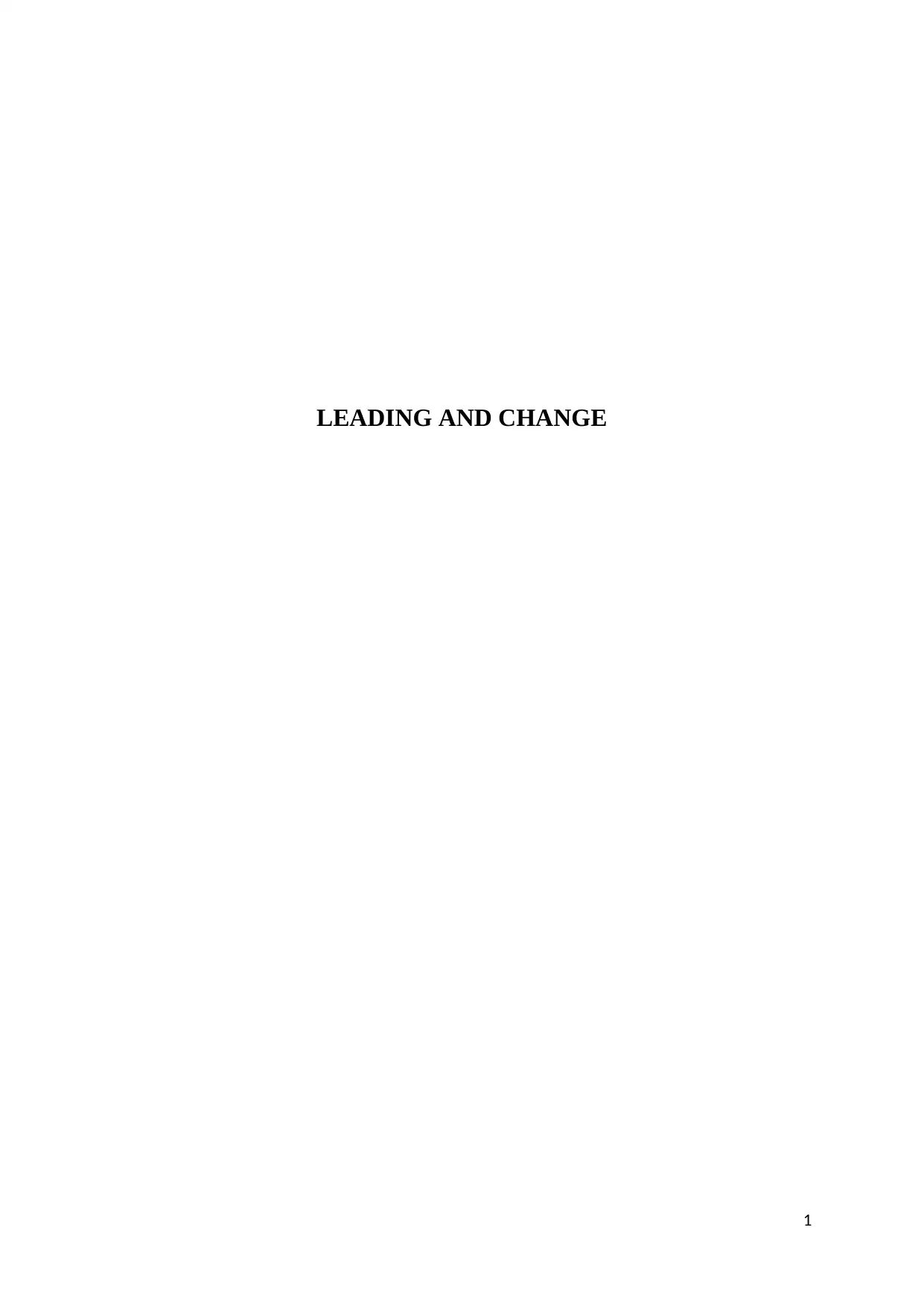
LEADING AND CHANGE
1
1
Paraphrase This Document
Need a fresh take? Get an instant paraphrase of this document with our AI Paraphraser
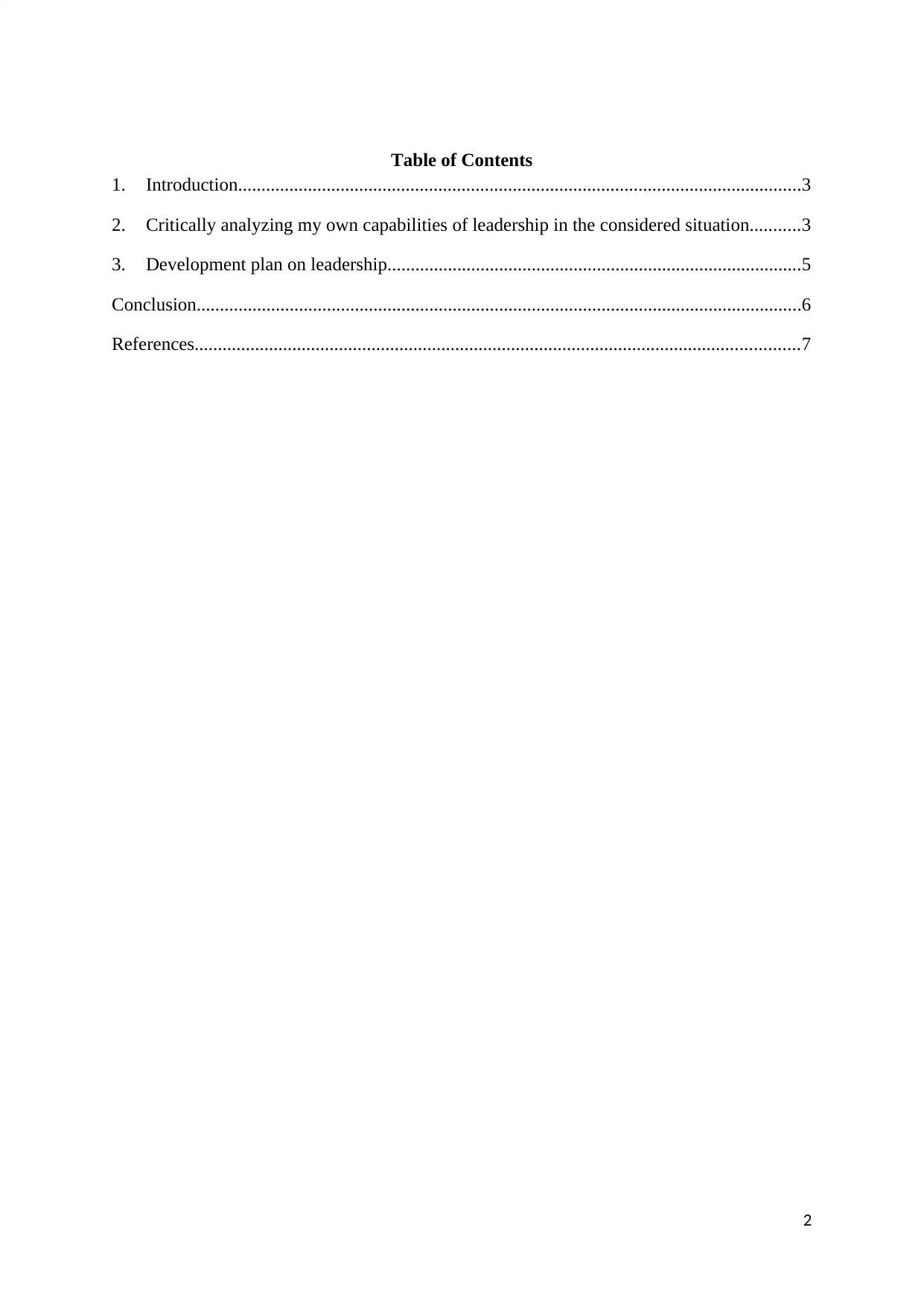
Table of Contents
1. Introduction.........................................................................................................................3
2. Critically analyzing my own capabilities of leadership in the considered situation...........3
3. Development plan on leadership.........................................................................................5
Conclusion..................................................................................................................................6
References..................................................................................................................................7
2
1. Introduction.........................................................................................................................3
2. Critically analyzing my own capabilities of leadership in the considered situation...........3
3. Development plan on leadership.........................................................................................5
Conclusion..................................................................................................................................6
References..................................................................................................................................7
2
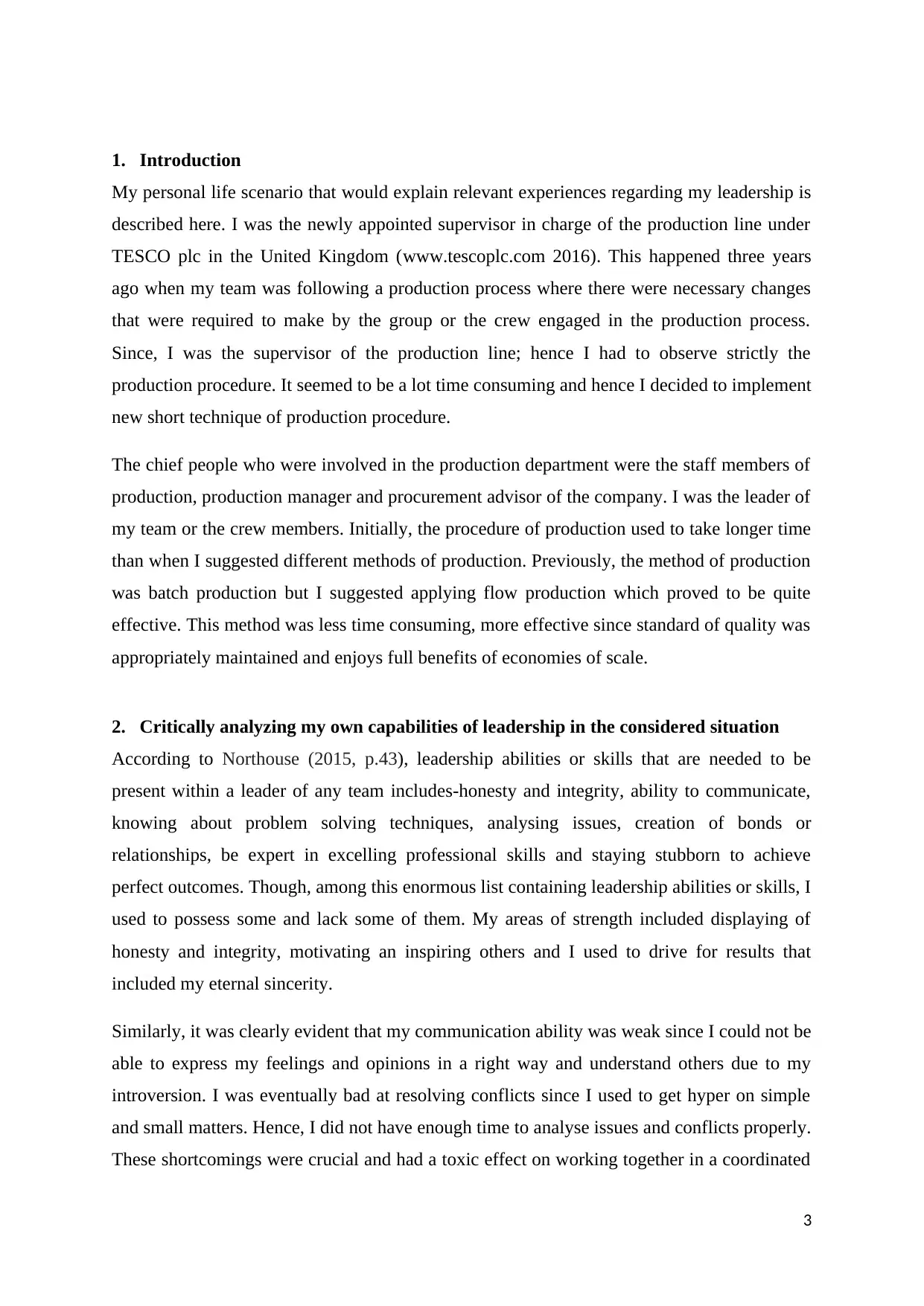
1. Introduction
My personal life scenario that would explain relevant experiences regarding my leadership is
described here. I was the newly appointed supervisor in charge of the production line under
TESCO plc in the United Kingdom (www.tescoplc.com 2016). This happened three years
ago when my team was following a production process where there were necessary changes
that were required to make by the group or the crew engaged in the production process.
Since, I was the supervisor of the production line; hence I had to observe strictly the
production procedure. It seemed to be a lot time consuming and hence I decided to implement
new short technique of production procedure.
The chief people who were involved in the production department were the staff members of
production, production manager and procurement advisor of the company. I was the leader of
my team or the crew members. Initially, the procedure of production used to take longer time
than when I suggested different methods of production. Previously, the method of production
was batch production but I suggested applying flow production which proved to be quite
effective. This method was less time consuming, more effective since standard of quality was
appropriately maintained and enjoys full benefits of economies of scale.
2. Critically analyzing my own capabilities of leadership in the considered situation
According to Northouse (2015, p.43), leadership abilities or skills that are needed to be
present within a leader of any team includes-honesty and integrity, ability to communicate,
knowing about problem solving techniques, analysing issues, creation of bonds or
relationships, be expert in excelling professional skills and staying stubborn to achieve
perfect outcomes. Though, among this enormous list containing leadership abilities or skills, I
used to possess some and lack some of them. My areas of strength included displaying of
honesty and integrity, motivating an inspiring others and I used to drive for results that
included my eternal sincerity.
Similarly, it was clearly evident that my communication ability was weak since I could not be
able to express my feelings and opinions in a right way and understand others due to my
introversion. I was eventually bad at resolving conflicts since I used to get hyper on simple
and small matters. Hence, I did not have enough time to analyse issues and conflicts properly.
These shortcomings were crucial and had a toxic effect on working together in a coordinated
3
My personal life scenario that would explain relevant experiences regarding my leadership is
described here. I was the newly appointed supervisor in charge of the production line under
TESCO plc in the United Kingdom (www.tescoplc.com 2016). This happened three years
ago when my team was following a production process where there were necessary changes
that were required to make by the group or the crew engaged in the production process.
Since, I was the supervisor of the production line; hence I had to observe strictly the
production procedure. It seemed to be a lot time consuming and hence I decided to implement
new short technique of production procedure.
The chief people who were involved in the production department were the staff members of
production, production manager and procurement advisor of the company. I was the leader of
my team or the crew members. Initially, the procedure of production used to take longer time
than when I suggested different methods of production. Previously, the method of production
was batch production but I suggested applying flow production which proved to be quite
effective. This method was less time consuming, more effective since standard of quality was
appropriately maintained and enjoys full benefits of economies of scale.
2. Critically analyzing my own capabilities of leadership in the considered situation
According to Northouse (2015, p.43), leadership abilities or skills that are needed to be
present within a leader of any team includes-honesty and integrity, ability to communicate,
knowing about problem solving techniques, analysing issues, creation of bonds or
relationships, be expert in excelling professional skills and staying stubborn to achieve
perfect outcomes. Though, among this enormous list containing leadership abilities or skills, I
used to possess some and lack some of them. My areas of strength included displaying of
honesty and integrity, motivating an inspiring others and I used to drive for results that
included my eternal sincerity.
Similarly, it was clearly evident that my communication ability was weak since I could not be
able to express my feelings and opinions in a right way and understand others due to my
introversion. I was eventually bad at resolving conflicts since I used to get hyper on simple
and small matters. Hence, I did not have enough time to analyse issues and conflicts properly.
These shortcomings were crucial and had a toxic effect on working together in a coordinated
3
⊘ This is a preview!⊘
Do you want full access?
Subscribe today to unlock all pages.

Trusted by 1+ million students worldwide
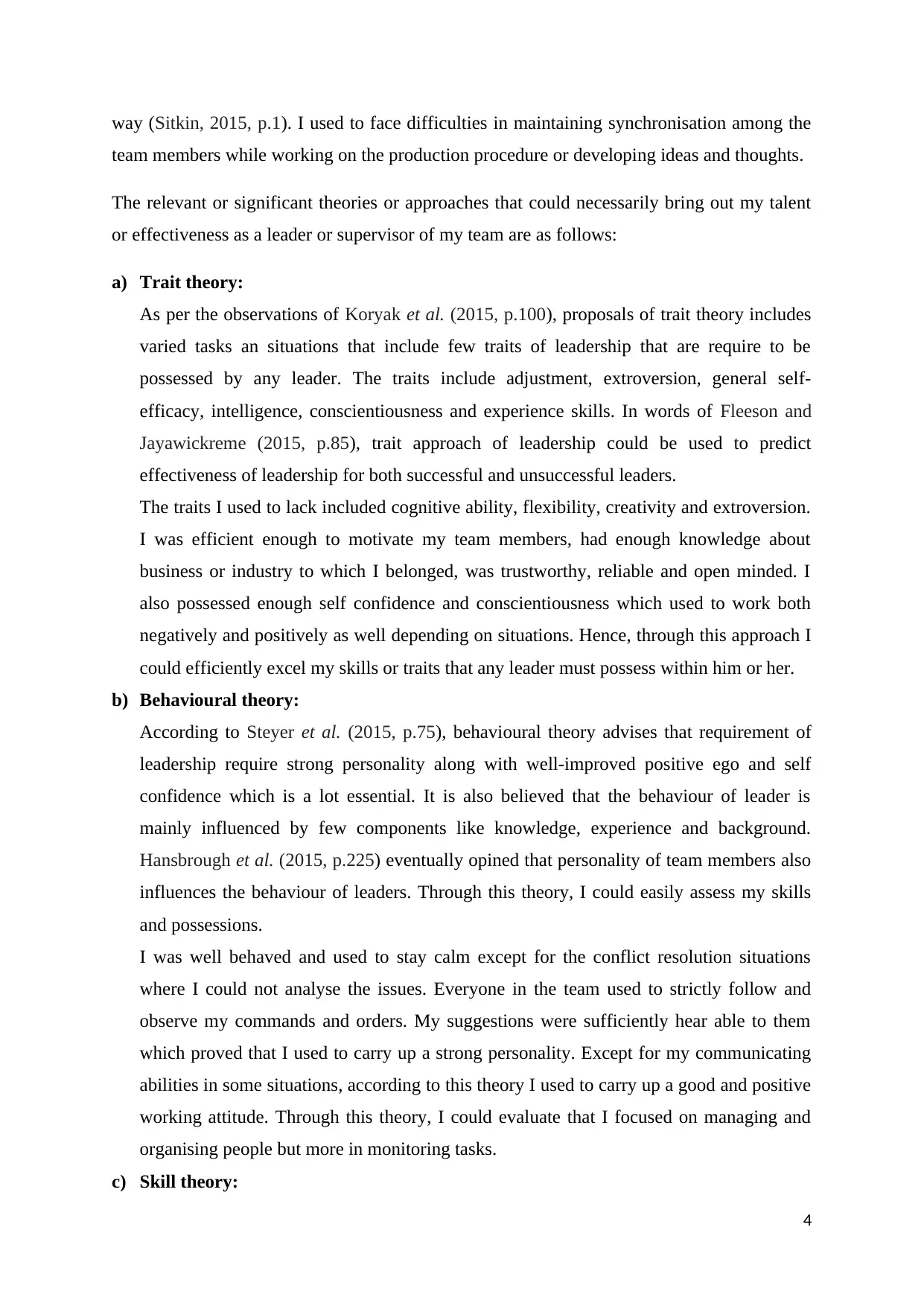
way (Sitkin, 2015, p.1). I used to face difficulties in maintaining synchronisation among the
team members while working on the production procedure or developing ideas and thoughts.
The relevant or significant theories or approaches that could necessarily bring out my talent
or effectiveness as a leader or supervisor of my team are as follows:
a) Trait theory:
As per the observations of Koryak et al. (2015, p.100), proposals of trait theory includes
varied tasks an situations that include few traits of leadership that are require to be
possessed by any leader. The traits include adjustment, extroversion, general self-
efficacy, intelligence, conscientiousness and experience skills. In words of Fleeson and
Jayawickreme (2015, p.85), trait approach of leadership could be used to predict
effectiveness of leadership for both successful and unsuccessful leaders.
The traits I used to lack included cognitive ability, flexibility, creativity and extroversion.
I was efficient enough to motivate my team members, had enough knowledge about
business or industry to which I belonged, was trustworthy, reliable and open minded. I
also possessed enough self confidence and conscientiousness which used to work both
negatively and positively as well depending on situations. Hence, through this approach I
could efficiently excel my skills or traits that any leader must possess within him or her.
b) Behavioural theory:
According to Steyer et al. (2015, p.75), behavioural theory advises that requirement of
leadership require strong personality along with well-improved positive ego and self
confidence which is a lot essential. It is also believed that the behaviour of leader is
mainly influenced by few components like knowledge, experience and background.
Hansbrough et al. (2015, p.225) eventually opined that personality of team members also
influences the behaviour of leaders. Through this theory, I could easily assess my skills
and possessions.
I was well behaved and used to stay calm except for the conflict resolution situations
where I could not analyse the issues. Everyone in the team used to strictly follow and
observe my commands and orders. My suggestions were sufficiently hear able to them
which proved that I used to carry up a strong personality. Except for my communicating
abilities in some situations, according to this theory I used to carry up a good and positive
working attitude. Through this theory, I could evaluate that I focused on managing and
organising people but more in monitoring tasks.
c) Skill theory:
4
team members while working on the production procedure or developing ideas and thoughts.
The relevant or significant theories or approaches that could necessarily bring out my talent
or effectiveness as a leader or supervisor of my team are as follows:
a) Trait theory:
As per the observations of Koryak et al. (2015, p.100), proposals of trait theory includes
varied tasks an situations that include few traits of leadership that are require to be
possessed by any leader. The traits include adjustment, extroversion, general self-
efficacy, intelligence, conscientiousness and experience skills. In words of Fleeson and
Jayawickreme (2015, p.85), trait approach of leadership could be used to predict
effectiveness of leadership for both successful and unsuccessful leaders.
The traits I used to lack included cognitive ability, flexibility, creativity and extroversion.
I was efficient enough to motivate my team members, had enough knowledge about
business or industry to which I belonged, was trustworthy, reliable and open minded. I
also possessed enough self confidence and conscientiousness which used to work both
negatively and positively as well depending on situations. Hence, through this approach I
could efficiently excel my skills or traits that any leader must possess within him or her.
b) Behavioural theory:
According to Steyer et al. (2015, p.75), behavioural theory advises that requirement of
leadership require strong personality along with well-improved positive ego and self
confidence which is a lot essential. It is also believed that the behaviour of leader is
mainly influenced by few components like knowledge, experience and background.
Hansbrough et al. (2015, p.225) eventually opined that personality of team members also
influences the behaviour of leaders. Through this theory, I could easily assess my skills
and possessions.
I was well behaved and used to stay calm except for the conflict resolution situations
where I could not analyse the issues. Everyone in the team used to strictly follow and
observe my commands and orders. My suggestions were sufficiently hear able to them
which proved that I used to carry up a strong personality. Except for my communicating
abilities in some situations, according to this theory I used to carry up a good and positive
working attitude. Through this theory, I could evaluate that I focused on managing and
organising people but more in monitoring tasks.
c) Skill theory:
4
Paraphrase This Document
Need a fresh take? Get an instant paraphrase of this document with our AI Paraphraser
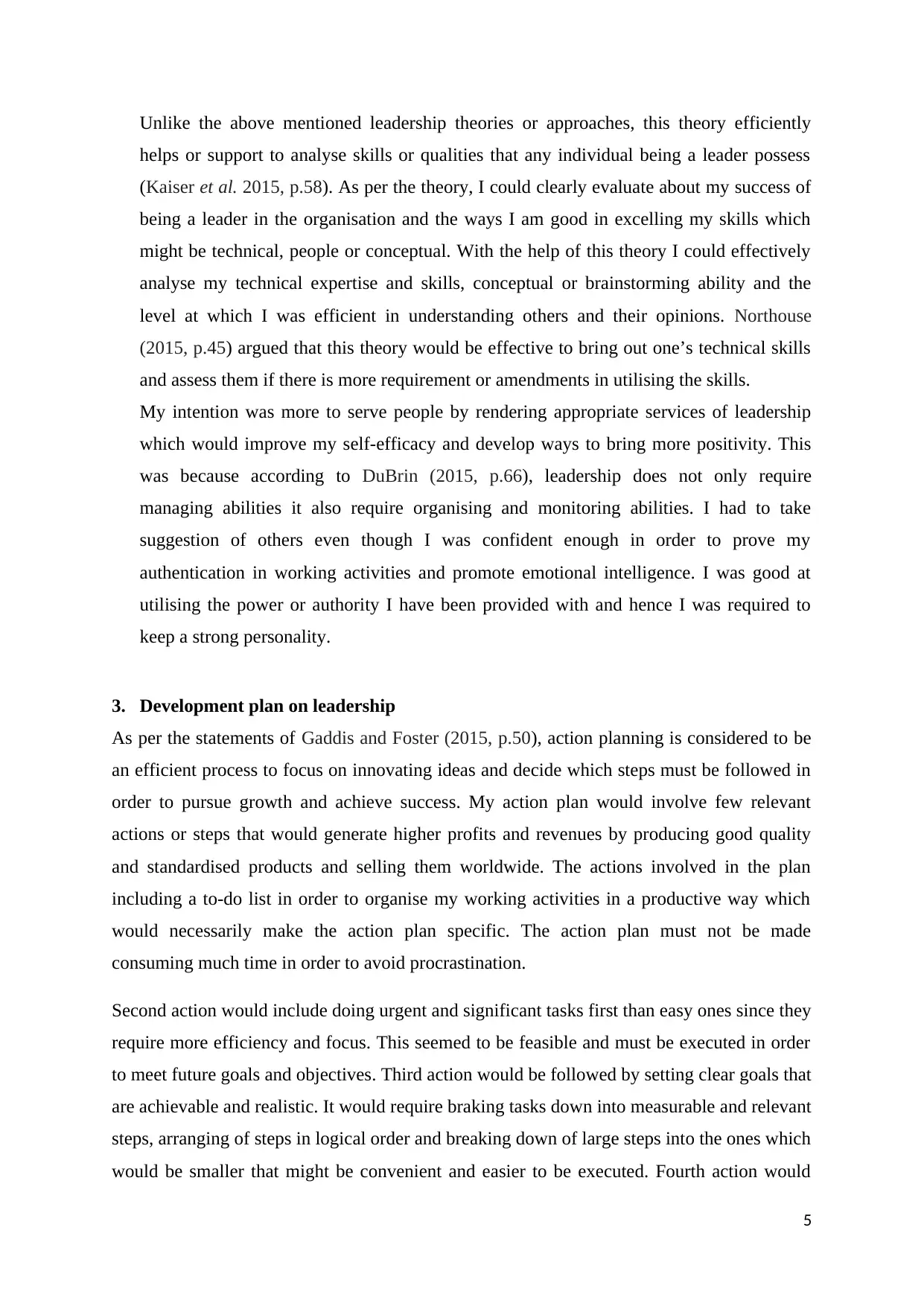
Unlike the above mentioned leadership theories or approaches, this theory efficiently
helps or support to analyse skills or qualities that any individual being a leader possess
(Kaiser et al. 2015, p.58). As per the theory, I could clearly evaluate about my success of
being a leader in the organisation and the ways I am good in excelling my skills which
might be technical, people or conceptual. With the help of this theory I could effectively
analyse my technical expertise and skills, conceptual or brainstorming ability and the
level at which I was efficient in understanding others and their opinions. Northouse
(2015, p.45) argued that this theory would be effective to bring out one’s technical skills
and assess them if there is more requirement or amendments in utilising the skills.
My intention was more to serve people by rendering appropriate services of leadership
which would improve my self-efficacy and develop ways to bring more positivity. This
was because according to DuBrin (2015, p.66), leadership does not only require
managing abilities it also require organising and monitoring abilities. I had to take
suggestion of others even though I was confident enough in order to prove my
authentication in working activities and promote emotional intelligence. I was good at
utilising the power or authority I have been provided with and hence I was required to
keep a strong personality.
3. Development plan on leadership
As per the statements of Gaddis and Foster (2015, p.50), action planning is considered to be
an efficient process to focus on innovating ideas and decide which steps must be followed in
order to pursue growth and achieve success. My action plan would involve few relevant
actions or steps that would generate higher profits and revenues by producing good quality
and standardised products and selling them worldwide. The actions involved in the plan
including a to-do list in order to organise my working activities in a productive way which
would necessarily make the action plan specific. The action plan must not be made
consuming much time in order to avoid procrastination.
Second action would include doing urgent and significant tasks first than easy ones since they
require more efficiency and focus. This seemed to be feasible and must be executed in order
to meet future goals and objectives. Third action would be followed by setting clear goals that
are achievable and realistic. It would require braking tasks down into measurable and relevant
steps, arranging of steps in logical order and breaking down of large steps into the ones which
would be smaller that might be convenient and easier to be executed. Fourth action would
5
helps or support to analyse skills or qualities that any individual being a leader possess
(Kaiser et al. 2015, p.58). As per the theory, I could clearly evaluate about my success of
being a leader in the organisation and the ways I am good in excelling my skills which
might be technical, people or conceptual. With the help of this theory I could effectively
analyse my technical expertise and skills, conceptual or brainstorming ability and the
level at which I was efficient in understanding others and their opinions. Northouse
(2015, p.45) argued that this theory would be effective to bring out one’s technical skills
and assess them if there is more requirement or amendments in utilising the skills.
My intention was more to serve people by rendering appropriate services of leadership
which would improve my self-efficacy and develop ways to bring more positivity. This
was because according to DuBrin (2015, p.66), leadership does not only require
managing abilities it also require organising and monitoring abilities. I had to take
suggestion of others even though I was confident enough in order to prove my
authentication in working activities and promote emotional intelligence. I was good at
utilising the power or authority I have been provided with and hence I was required to
keep a strong personality.
3. Development plan on leadership
As per the statements of Gaddis and Foster (2015, p.50), action planning is considered to be
an efficient process to focus on innovating ideas and decide which steps must be followed in
order to pursue growth and achieve success. My action plan would involve few relevant
actions or steps that would generate higher profits and revenues by producing good quality
and standardised products and selling them worldwide. The actions involved in the plan
including a to-do list in order to organise my working activities in a productive way which
would necessarily make the action plan specific. The action plan must not be made
consuming much time in order to avoid procrastination.
Second action would include doing urgent and significant tasks first than easy ones since they
require more efficiency and focus. This seemed to be feasible and must be executed in order
to meet future goals and objectives. Third action would be followed by setting clear goals that
are achievable and realistic. It would require braking tasks down into measurable and relevant
steps, arranging of steps in logical order and breaking down of large steps into the ones which
would be smaller that might be convenient and easier to be executed. Fourth action would
5
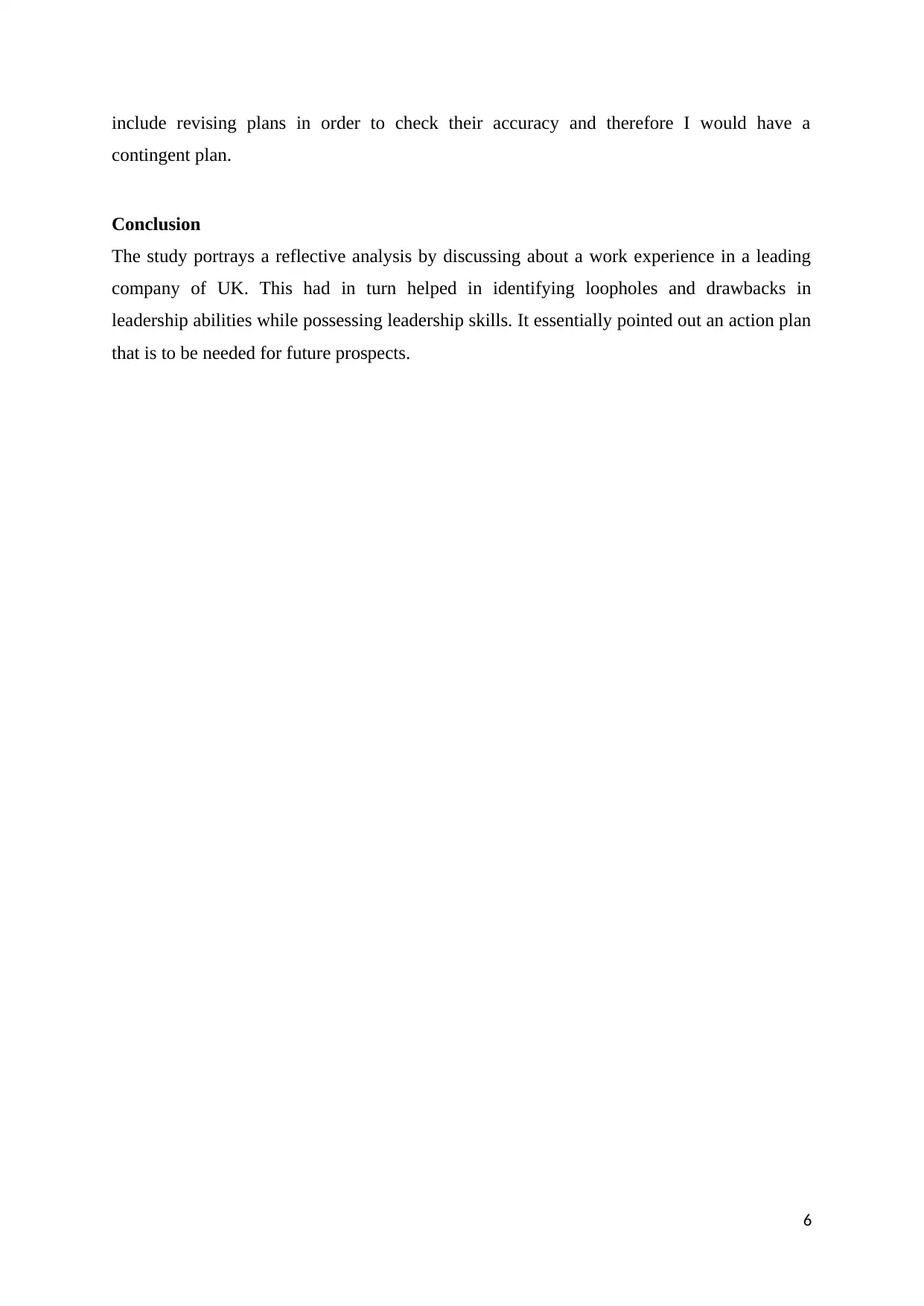
include revising plans in order to check their accuracy and therefore I would have a
contingent plan.
Conclusion
The study portrays a reflective analysis by discussing about a work experience in a leading
company of UK. This had in turn helped in identifying loopholes and drawbacks in
leadership abilities while possessing leadership skills. It essentially pointed out an action plan
that is to be needed for future prospects.
6
contingent plan.
Conclusion
The study portrays a reflective analysis by discussing about a work experience in a leading
company of UK. This had in turn helped in identifying loopholes and drawbacks in
leadership abilities while possessing leadership skills. It essentially pointed out an action plan
that is to be needed for future prospects.
6
⊘ This is a preview!⊘
Do you want full access?
Subscribe today to unlock all pages.

Trusted by 1+ million students worldwide
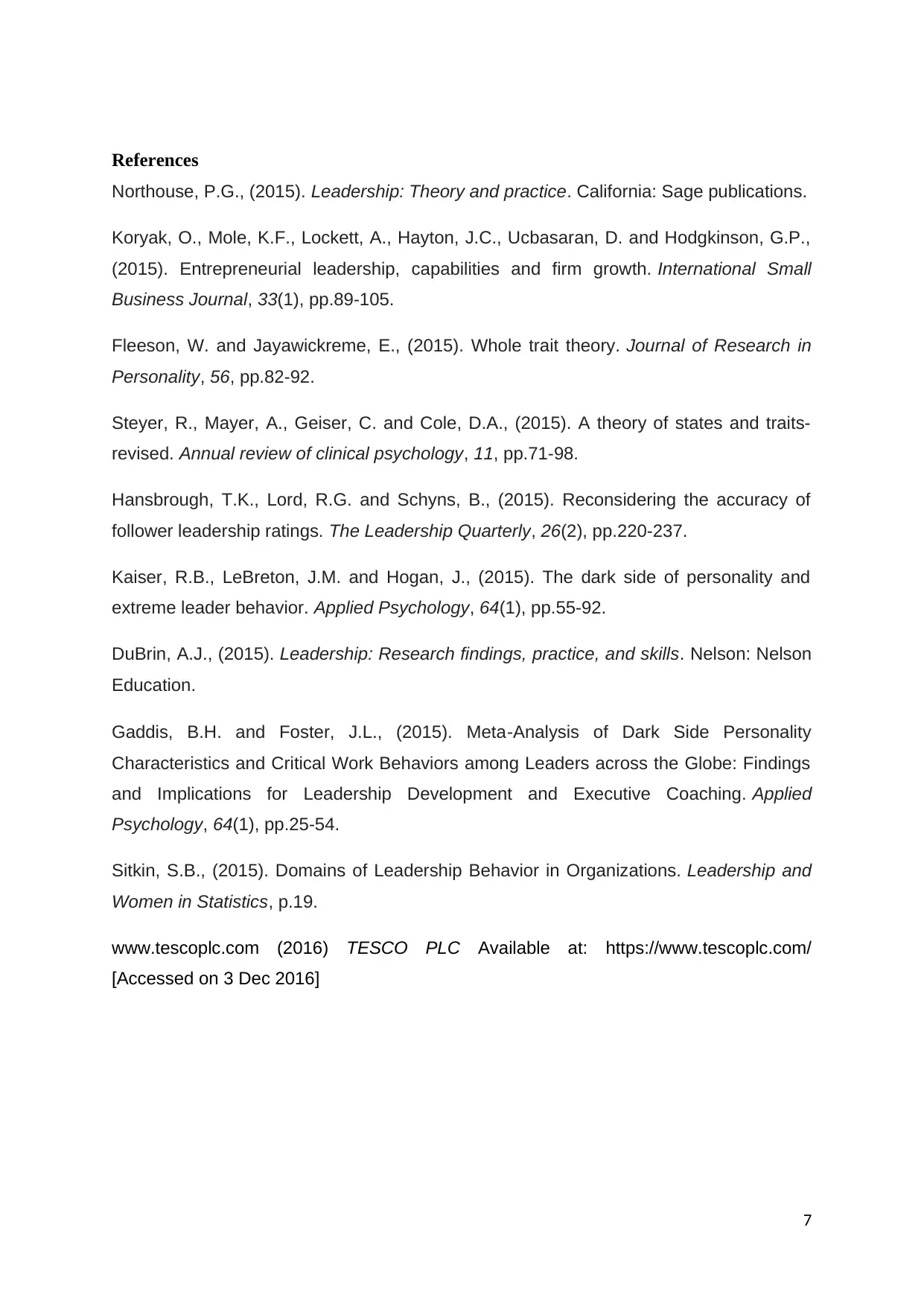
References
Northouse, P.G., (2015). Leadership: Theory and practice. California: Sage publications.
Koryak, O., Mole, K.F., Lockett, A., Hayton, J.C., Ucbasaran, D. and Hodgkinson, G.P.,
(2015). Entrepreneurial leadership, capabilities and firm growth. International Small
Business Journal, 33(1), pp.89-105.
Fleeson, W. and Jayawickreme, E., (2015). Whole trait theory. Journal of Research in
Personality, 56, pp.82-92.
Steyer, R., Mayer, A., Geiser, C. and Cole, D.A., (2015). A theory of states and traits-
revised. Annual review of clinical psychology, 11, pp.71-98.
Hansbrough, T.K., Lord, R.G. and Schyns, B., (2015). Reconsidering the accuracy of
follower leadership ratings. The Leadership Quarterly, 26(2), pp.220-237.
Kaiser, R.B., LeBreton, J.M. and Hogan, J., (2015). The dark side of personality and
extreme leader behavior. Applied Psychology, 64(1), pp.55-92.
DuBrin, A.J., (2015). Leadership: Research findings, practice, and skills. Nelson: Nelson
Education.
Gaddis, B.H. and Foster, J.L., (2015). Meta‐Analysis of Dark Side Personality
Characteristics and Critical Work Behaviors among Leaders across the Globe: Findings
and Implications for Leadership Development and Executive Coaching. Applied
Psychology, 64(1), pp.25-54.
Sitkin, S.B., (2015). Domains of Leadership Behavior in Organizations. Leadership and
Women in Statistics, p.19.
www.tescoplc.com (2016) TESCO PLC Available at: https://www.tescoplc.com/
[Accessed on 3 Dec 2016]
7
Northouse, P.G., (2015). Leadership: Theory and practice. California: Sage publications.
Koryak, O., Mole, K.F., Lockett, A., Hayton, J.C., Ucbasaran, D. and Hodgkinson, G.P.,
(2015). Entrepreneurial leadership, capabilities and firm growth. International Small
Business Journal, 33(1), pp.89-105.
Fleeson, W. and Jayawickreme, E., (2015). Whole trait theory. Journal of Research in
Personality, 56, pp.82-92.
Steyer, R., Mayer, A., Geiser, C. and Cole, D.A., (2015). A theory of states and traits-
revised. Annual review of clinical psychology, 11, pp.71-98.
Hansbrough, T.K., Lord, R.G. and Schyns, B., (2015). Reconsidering the accuracy of
follower leadership ratings. The Leadership Quarterly, 26(2), pp.220-237.
Kaiser, R.B., LeBreton, J.M. and Hogan, J., (2015). The dark side of personality and
extreme leader behavior. Applied Psychology, 64(1), pp.55-92.
DuBrin, A.J., (2015). Leadership: Research findings, practice, and skills. Nelson: Nelson
Education.
Gaddis, B.H. and Foster, J.L., (2015). Meta‐Analysis of Dark Side Personality
Characteristics and Critical Work Behaviors among Leaders across the Globe: Findings
and Implications for Leadership Development and Executive Coaching. Applied
Psychology, 64(1), pp.25-54.
Sitkin, S.B., (2015). Domains of Leadership Behavior in Organizations. Leadership and
Women in Statistics, p.19.
www.tescoplc.com (2016) TESCO PLC Available at: https://www.tescoplc.com/
[Accessed on 3 Dec 2016]
7
1 out of 7
Related Documents
Your All-in-One AI-Powered Toolkit for Academic Success.
+13062052269
info@desklib.com
Available 24*7 on WhatsApp / Email
![[object Object]](/_next/static/media/star-bottom.7253800d.svg)
Unlock your academic potential
Copyright © 2020–2025 A2Z Services. All Rights Reserved. Developed and managed by ZUCOL.





